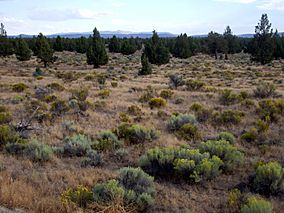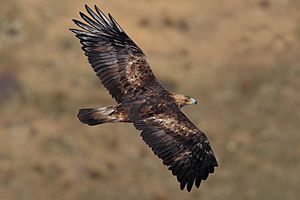Oregon Badlands Wilderness facts for kids
Quick facts for kids Oregon Badlands Wilderness |
|
|---|---|
|
IUCN Category Ib (Wilderness Area)
|
|

Oregon Badlands with sagebrush in bloom, Juniper trees, and proximity to Oregon Cascades
|
|
| Location | Deschutes / Crook counties, Oregon, United States |
| Nearest city | Bend, Oregon |
| Area | 29,301 acres (11,858 ha) |
| Established | United States Bureau of Land Management |
The Oregon Badlands Wilderness is a special protected area of about 29,301-acre (11,858 ha) in Oregon, USA. It's located east of Bend in Deschutes and Crook counties. This wilderness is managed by the Bureau of Land Management (BLM). It became a protected wilderness area on March 30, 2009, when President Barack Obama signed a law called the Omnibus Public Land Management Act of 2009.
This area is famous for its unique landscape. You can find rock formations that look like castles, tough terrain, very old Juniper trees, and sagebrush. It's a dry, desert-like place. You might also discover desert wildflowers, dry river canyons, and ancient Native American pictographs (rock drawings).
The famous blind dog sled racer Rachel Scdoris used to train here. The western end of the Oregon Desert Trail also starts in this wilderness.
Contents
Exploring the Badlands Geology
The Oregon Badlands Wilderness sits in a high desert area. Its unique landscape was formed by ancient volcanoes. About 80,000 years ago, lava flowed from a special kind of volcano called a "rootless shield." This means the lava came from a vent (opening) that wasn't directly connected to a deep magma chamber.
The lava came from a main vent near Lava Top Butte, which is part of Newberry Volcano. This lava traveled through underground tunnels called the Arnold Lava Tube System to reach the Badlands. At the top of the shield, there's an uneven pit crater where the lava spread out in all directions. Some of the lava also flowed through lava tubes, which are like natural pipes. On the surface, you can see bumps called tumuli or pressure ridges, which show where these tubes are.
The soil in the Badlands was mostly created from ash that fell during the eruption of Mount Mazama about 7,700 years ago. This wilderness is part of the Northern Basin and Range ecoregion, which is a large dry region. It shares many features with the Great Basin.
Amazing Plants and Animals
The plants in the Oregon Badlands Wilderness are very tough. They have learned to live with less than 12 inches (30 cm) of rain each year. Some Western juniper trees here are incredibly old, living for over 1,000 years! The oldest known tree in Oregon, which is thought to be more than 1,600 years old, grows close to this wilderness.
Other common plants you'll see include big sagebrush, rabbitbrush, and different types of bunchgrasses. These include Idaho fescue and bluebunch wheatgrass. In the spring, the area bursts with colorful wildflowers. Look for Oregon sunshine, dwarf monkeyflower, sulfur buckwheat, Indian paintbrush, and mariposa lily.
Many different animals call this wilderness home. You might spot black-tailed jackrabbits, mule deer, elk, pronghorn, cottontail rabbits, coyotes, bats, and six kinds of lizards. More than 100 types of birds live here too, such as the powerful golden eagle, the sage grouse, and the speedy prairie falcon.
Protecting the Wilderness
The Bureau of Land Management (BLM) is in charge of looking after the Oregon Badlands Wilderness. Before it became a wilderness area, the BLM worked with volunteers to clean up and restore the land. These volunteers later formed a group called "Friends of Oregon Badlands Wilderness." They spent over 1,200 hours mapping the area, fixing trails, putting up signs, and removing old fences that were dangerous for wildlife. By 2010, this group had organized over 200 local people to help with these projects.
In 2010, the BLM stopped a cattle grazing permit in an area next to the wilderness. This area, called the Juniper Woodlands Special Management Area, has very old juniper trees that are important for deer and elk. A group called the Oregon Natural Desert Foundation paid the rancher about $10,000 to end their grazing rights. This decision was supported by local landowners and the Deschutes County Commission. It helped protect the natural environment and reduce conflicts with hikers and people riding horses.
The BLM is still working on a plan to manage the wilderness. This plan will help make sure the area stays wild and beautiful. It will also offer chances for people to enjoy nature and quiet activities, while also managing other land uses.
How the Wilderness Was Designated
The BLM first identified the Oregon Badlands as a special area to study for wilderness protection in 1980. They officially suggested it become a federal wilderness in 1989. Many local people supported this idea over the years. However, there were some disagreements, especially about cattle grazing rights and whether off-highway vehicles (OHVs) should be allowed.
Some groups, like the Oregon Cattleman's Association and a group supporting OHV access, were against the wilderness designation. But many others supported it, including the Oregon Natural Desert Association (ONDA) and the city leaders of Bend. Even a rancher named Ray Clarno, who had grazing rights in the area, supported it. He said that off-road riders were cutting his fences and leaving gates open, which caused problems for his cattle. He promised to give up his grazing rights if OHVs were banned. He kept his promise in 2005 when the BLM stopped OHVs from entering the Badlands.
The law that created the wilderness area also included plans for land swaps. This meant that some private land would be traded for public land. This helped get support from groups like the Central Oregon Irrigation District.
Over the years, support for wilderness designation grew. Polls in 2002 and 2004 showed that more and more people in Deschutes County wanted the area to be protected. In 2004, 57% of people surveyed supported creating a wilderness area, while only 28% were against it. Finally, on March 30, 2009, the Oregon Badlands officially became a wilderness area with the passage of the Omnibus Public Land Management Act of 2009.



